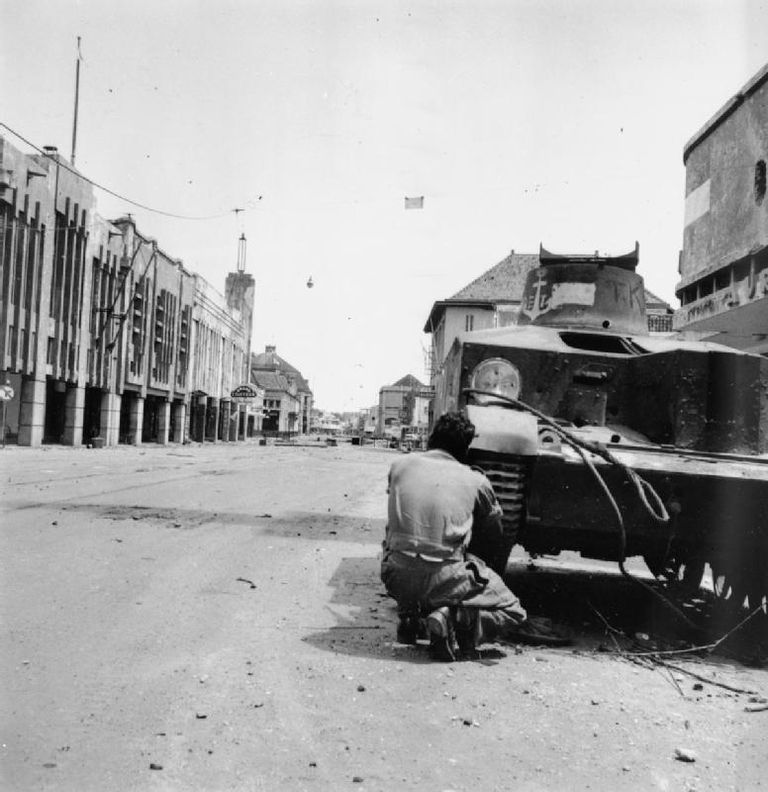
Photograph: IWM/Wikimedia
Surabaya, October 28, 1945. A few hours after General Major Moestopo and Resident Sudirman left the headquarters of the 49th Brigade of the British Indian Army (BIA), silence fell throughout the city. The tense situation was intertwined with the busyness of the Indonesian fighters who began to reassemble the brigades on the streets. Not only cutting down trees which are then crossed in the middle of the road, they also put various household appliances such as chairs, tables, cabinets and kitchen utensils as obstacles.
At around 16:00, the first battle began. The areas around the Surabaya Radio Building, Kayoon and others became a fierce battleground. At the same time, slowly from various corners of the city, approximately 140,000 people (20,000 of whom had been trained in the Japanese military) approached the positions of the British troops, which numbered only 4000 soldiers.
"Until midnight almost all British posts were surrounded," said Nugroho Notosusanto during the Battle of Surabaya.
The atmosphere became even more tense when the Indonesian fighters suddenly turned off the electricity in the entire city, also phone calls. The power outage made the supply of clean water to British military posts stopped instantly. Frustrated by these conditions, the British military then began to beat positions outside their posts by using artillery indiscriminately.
P.R.S Mani, a member of the 49th Brigade, witnessed how panic hit the British soldiers. There was no other way, in the midst of the breakdown of communication between the troop units, the British soldiers could only defend themselves by shooting at everything that moved in their path.
"On the radio we heard all the conversations between the Headquarters and the units each sending an SOS (danger signal) signal," recalled Mani in The Story of Indonesian Revolution 1945-1950.
Fierce fighting continued until midnight. According to the British military historian A.J.F. Doulton, the British soldiers were almost desperate to face the waves of enemy attacks that seemed never ending. The Indonesian fighters fought fanatically without taking into account the victims who fell.
"If one of them dies, then the place will be immediately replaced with someone else. A very terrible sight" said Doulton in The Fighting Cock, The Story of the 23RD Indian Division.
Until October 29, 1945, the position of the British troops' defense was increasingly critical. Even though they have abundant military equipment, destruction still threatened the victors of World War II. The tense situation was not only experienced by British soldiers in the middle of a city that was already under siege, in the Tanjung Perak Harbor area they had to take shelter around the harbor docks.
Slowly but surely, some places were again taken by Indonesian fighters, including the Morokrembangan Airport. Likewise the BPM Building, the Internatio Building near the Red Bridge and the Lindeteves Building near the Ant Bridge were under the siege of the Republicans.
Thirty years later, a veteran of the Battle of Surabaya named R.C. Smith (then captain) made a confession to historian J.G.A. Parrots. Smith's confession written by Parrot in the Indonesian Journal published by Cornell University in July 1976 stated that during the two-day battle, Brigadier A.W.S. Mallaby (Commander of the 49th Brigade) was already worried that if all this could not be stopped, all his men would be wiped out.
Smith's statement was corroborated by Doulton. The British army veteran assessed that if the people of Surabaya were allowed to continue to act, the battle would only end with the destruction of the 49th Brigade in a foreign city called Surabaya.
"Unless there's someone who can control those people's anger," said Doulton.